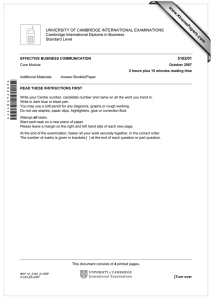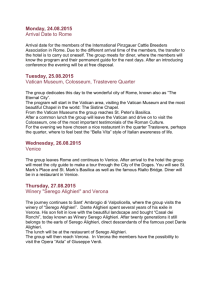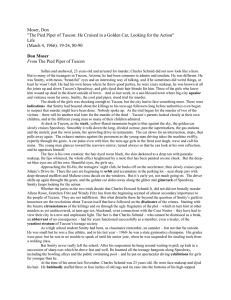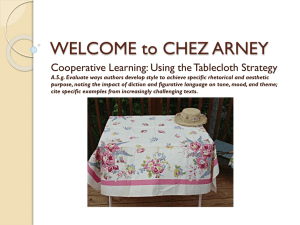How I became a Waitress and learned that there is no division
advertisement
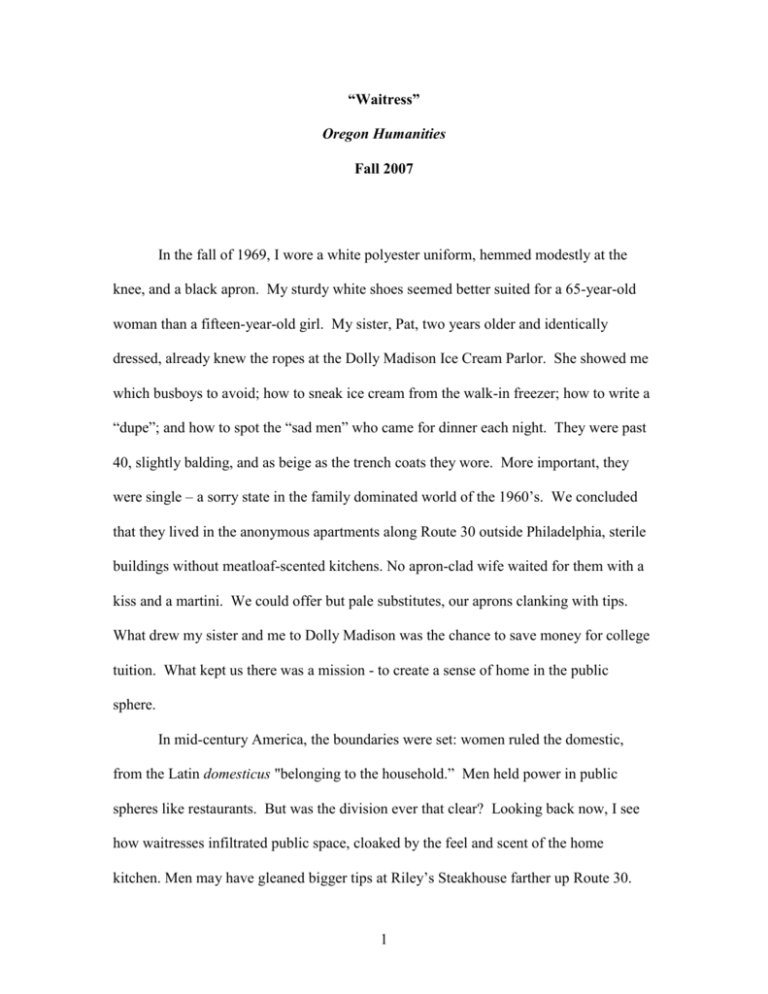
“Waitress” Oregon Humanities Fall 2007 In the fall of 1969, I wore a white polyester uniform, hemmed modestly at the knee, and a black apron. My sturdy white shoes seemed better suited for a 65-year-old woman than a fifteen-year-old girl. My sister, Pat, two years older and identically dressed, already knew the ropes at the Dolly Madison Ice Cream Parlor. She showed me which busboys to avoid; how to sneak ice cream from the walk-in freezer; how to write a “dupe”; and how to spot the “sad men” who came for dinner each night. They were past 40, slightly balding, and as beige as the trench coats they wore. More important, they were single – a sorry state in the family dominated world of the 1960’s. We concluded that they lived in the anonymous apartments along Route 30 outside Philadelphia, sterile buildings without meatloaf-scented kitchens. No apron-clad wife waited for them with a kiss and a martini. We could offer but pale substitutes, our aprons clanking with tips. What drew my sister and me to Dolly Madison was the chance to save money for college tuition. What kept us there was a mission - to create a sense of home in the public sphere. In mid-century America, the boundaries were set: women ruled the domestic, from the Latin domesticus "belonging to the household.” Men held power in public spheres like restaurants. But was the division ever that clear? Looking back now, I see how waitresses infiltrated public space, cloaked by the feel and scent of the home kitchen. Men may have gleaned bigger tips at Riley’s Steakhouse farther up Route 30. 1 But in their black and white penguin dress, floating between tables like smoke, waiters were barely present. They couldn’t banter with customers or ease their loneliness. At sixteen, I advanced to blue polyester and a white apron a few miles up the road at the Mari-Nay Diner. The Dolly Madison had morphed into the Lemon Meringue Pie Shop, then went bust (but not before my family had our fill of left-over chocolate cream and strawberry pies). At the diner, men stayed in the kitchen, while women reigned out front. Kindly old Joe fried the fish his brother caught at the Jersey shore. Rebel, the line cook, liked to taunt me for customers to hear. “You’re so skinny if you stood sideways and stuck out your tongue, you’d be a zipper.” “Don’t pay him no mind, hon,” Bea instructed, smoothing her white hair into a net. I apprenticed myself to Bea, Pat and Marie, the older waitresses who kept steady the flow of conversation. “How’s the missus? Did Joey make Little League?” On weekends, Bea’s days off, I worked her station – the sacrosanct counter of aluminum edged Formica lined by twelve shining stools with red leather seats. Each day, the regulars tested me. Some placed their orders as they approached — “Two over easy with rye toast” — expecting the plates at their usual spot when they sit down. And would the “new girl” remember the extra cream with coffee? I scrambled to match the barrage of orders to customer’s faces. During five years at the diner, including a stint after I dropped out of college, I discovered that regulars were not just sad men; many people came to restaurants for a sense of home. There was Linda, who worked for a law firm, a blonde beauty who told me stories of caring for her dying mother. There was Mr. Evans, who wore a wedding ring but ate at the diner almost every night. When his wife made a surprise appearance 2 after church one Sunday in a mink stole, the waitresses breathed a collective “aha.” Casseroles in the kitchen didn’t jive with fur coats. After my first year, Bea’s customers began to trust me. They revealed hardships at home, pride in their families, and brought me birthday gifts and Christmas cards stuffed with dollar bills. Yet one diehard for whom I remained an interloper was Smitty, an ancient bent Irishman who ran coffees for the workmen at the Chevron station across the street. Smitty had lost his fingers to an accident in the “old country.” I suspected he lost more than fingers. He ranted incoherently at Bea’s counter – a self-styled diner sage in a torn tweed jacket and plaid cap. Only proven waitresses could fill his take-out order: Marie, a redheaded fellow Irish compatriot and Bea, who knew how to position the cups just so between the stubs on each hand. My first year working the counter, I labored to win a smile from Smitty. But I suspected he’d never trust a young girl with so little experience of the world. During a slow season at the diner, I moved to the private Merion Cricket Club, where the Irish waitresses from Donegal lived on the grounds in rickety wooden dormitories. Our black cotton dresses with white ruffled aprons completed the “Upstairs/Downstairs” picture. As the years passed, I found myself dressed in a kaleidoscope of costumes: hot pants and boots at Dummy’s Delightful Saloonery; a red cowgirl shirt and hat at Roy Rogers; a sailor get-up at the Windjammer Lounge, and a string of other outfits. By the time I graduated from college, I’d worked in sixteen restaurants. I’d also devoured Simone de Beauvoir and the feminist classics. Suddenly, inequities glared in every waitress job I found as I moved around the country. Women sweated through breakfast and lunch, created intimacy with customers, yet carried home 3 half the wages of their male counterparts at dinner. The power to domesticate, I realized, just wasn’t enough. As I worked my way through graduate school, I demanded night shifts to make wages equal to men’s. At thirty-three, an MA in anthropology and a PhD in folklore in hand, I reached the pinnacle — a French restaurant in Seattle. I joined the Big Boys, sporting black and white for dinner shift, bringing home $150.00 on a Saturday night. No more gendered terms: we were all “wait staff.” For two years, I basked in equality, good tips, and camaraderie with the other waiters. One afternoon, a group of overweight tourists in Bermuda shorts stopped for an early dinner as they awaited the Alaska ferry. The other waiters balked, smelling a lousy tip, but in the group, I saw my former Mari-Nay Diner customers. Waiting on them, I slid into the bantering and joking that I hadn’t realized I’d missed. Then, a sprained ankle kept me from work for three weeks, and I knew I had to give up restaurants. Maybe the prize of equality arrived too late; my body felt battered from nearly twenty years as a waitress. Maybe the trade of intimacy with customers for higher wages felt bittersweet. Finally, I found what some friends considered my first “real job” — coordinating an arts program and teaching at a liberal arts college — work for which my tenure in restaurants seemed scant preparation. In 1990, I began teaching anthropology and gender studies. In both domains, debates circled the question of power. Throughout anthropology’s history, most fieldworkers who studied power were men; not surprisingly, they found it in the public square and the chief’s hut – male arenas. Emphasis began to shift in the mid-twentieth century. In Male and Female, Margaret Mead famously wrote that when men “cook or weave, or dress dolls or hunt hummingbirds,” such work is respected. “When the same 4 occupations are performed by women, they are regarded as less important.” Then, in the 1970’s, a book called Woman, Culture and Society rocked the anthropological boat with questions. How do women exercise power? Is the public-private division always the critical boundary? My class debated whether we could look to the kitchen, the sewing circle, and the bedroom as places of power. In our discussions, I could have reached for examples from my own fieldwork with Native Alaskan women — an exploration I’d begun while a waitress on Kodiak Island. I might have drawn on oral histories with Latinas in Oregon that revealed women’s considerable influence in the family. Instead, I found myself back at the Mari-Nay Diner on a clear spring day during my second year. Early morning light shimmers on the aluminum door as I get ready to open the diner at 5 o’clock. Smitty arrives behind me, brandishing his cane, plaid cap tipped to one side. Instead of his usual muttering, he whispers, “Lovely day, lass.” From under the soiled cuff of his tweed jacket appears a small bouquet of white azaleas. I reach for the flowers, feeling how the years have smoothed the knobby flesh of Smitty’s stubs. We traverse the threshold of the diner together, dissolving the divisions: male and female, public and private, customer and waitress, the brokenness of a sad man and the still fresh hope of a young woman. I steady the coffee cups between Smitty’s stubs, finding perfect balance. The memory brings grief as well as pleasure, for I know now how rare such moments of wholeness are, how fragile the selves we lift beyond our divides. 5



